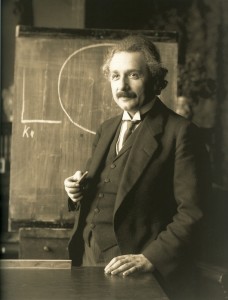
On May 29, 1919, astronomers had travelled to the remote island of Principe off the coast of Africa to observe a solar eclipse and measure how much the sun’s gravity would “bend” the light from the Hyades star cluster. Einstein’s new theory of general relativity predicted a certain bend, that is, stars might not appear to be where we would expect to see them if the light travelled in a truly straight line. The goal of the expedition was to test this hypothesis, and, in a sense, to put general relativity to the test. The measurements supported Einstein’s theory and in a short time, Einstein became world famous to scientists and laymen alike.
It is nice to think of scientists encountering this question of how to really think about straight lines in the universe. It’s a bit of the opposite of the challenge that one might face in learning Euclidean geometry where one has to figure out what it could mean for a line to be straight independent of our intuitive notions gleaned from our experience with the physical universe.
In 1920, a letter to the editor of the journal Nature begins as follows:
Since the results of the Eclipse Expedition of May last have been made public a very great deal of general interest has been displayed in a theory which, until a few weeks ago, was known only to mathematicians and physicists. Even among these, not many could offer any adequate explanation of the new view of space and time and their mutual relations, while some regarded the whole question as a mathematical joke which led to interesting results of no practical value; and probably not a few thought that a non-Euclidean system of geometry was inadmissible in any physical theory of the universe. On the other hand, there are some who have gone so far as to advocate that non-Euclidean geometry should be taught to boys and girls in secondary schools. The published books on this subject do not come into touch with any ordinary experience, and the whole subject, consequently, has been regarded as a mathematical fiction.
The letter was titled, Euclid, Newton, and Einstein, and had the purpose of elucidating some ways we have some physical intuition for (or at least experience of) non-euclidean geometry. This is an interesting topic, but it piqued my interest that among the first concerns raised were those of pedagogy. Maybe we should start teaching non-Euclidean geometry to the kids.
The implicit idea here is two-fold. First, if the Universe is not Euclidean, maybe Euclidean geometry was the “mathematical joke which led to interesting results of no practical value”. Second, if the scientists of the future would depend on non-Euclidean geometry to unravel the secrets of the universe, the sooner we get them started, the better.
In response to this second idea, it’s worth considering the esteem with which Einstein himself regarded Euclid’s Elements:
To Albert Einstein, who received what he called his “holy” book of Euclidean geometry at age 12, it was a veritable “wonder.”
He wrote: “Here were assertions . . . which—though by no means evident—could nevertheless be proved with such certainty that any doubt appeared to be out of the question. This lucidity and certainty made an indescribable impression upon me. . . .” *
Einstein gave an even stronger endorsement in his essay On The Method of Theoretical Physics
If Euclid failed to kindle your youthful enthusiasm, then you were not born to be a scientific thinker.
So, although Einstein ushered in a new era in geometrical understanding of the universe that was decidedly not Euclidean, it’s clear that his preparation for doing so was grounded in The Elements.
* In Paul A. Schilpp, ed., Albert Einstein: Philosopher- Scientist (Evanston, IL: Library of Living Philosophers, Inc., 1949) p. 9. Full excerpt taken from Henri Poincaré, Marcel Duchamp and Innovation in Science and Art by Gerald Holton